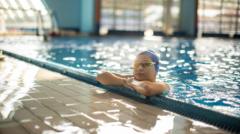Could Pool Closures Increase Drowning Risks for Young People?

Published: 2025-08-26 05:20:17 | Category: wales
Young people in the UK face increasing risks of drowning due to a sharp decline in the number of public swimming pools, with over 500 closures reported in the last decade. This alarming trend, highlighted by the GMB union, has intensified calls for renewed investment in swimming facilities to ensure that children have access to essential life skills like swimming.
Last updated: 10 October 2023 (BST)
Key Takeaways
- Over 500 public swimming pools have closed since 2010, with nearly half shutting down during the pandemic.
- 30% of Year 7 students are unable to swim 25 metres confidently, an increase from previous years.
- Urgent calls for funding are being made by a coalition including the Local Government Association (LGA) and Swim England.
- Many existing pools are in need of refurbishment, with 60% beyond their expected lifespan.
- The long-term effects of pool closures could lead to increased risks of drowning among young people.
The Decline of Public Swimming Pools in the UK
The GMB union's recent study highlights a concerning trend in the availability of public swimming facilities across the UK. Since 2010, more than 500 pools have closed, a statistic that has raised alarm bells regarding the safety and well-being of young people. Almost half of these closures occurred after the onset of the COVID-19 pandemic, leaving communities without crucial resources for leisure and safety.
Impact on Children and Swimming Confidence
According to the coalition's report, the percentage of children in Year 7 who cannot swim 25 metres confidently has risen to 30%, up from 27% in 2017/18. This increase is particularly alarming as swimming is considered a vital life skill that can help prevent drowning. The lack of facilities has direct consequences on children's ability to learn this essential skill.
Geographical Spread of Pool Closures
The closures have not been limited to a specific region; they have affected council-owned swimming pools across various parts of the UK, including London, the Midlands, the South West, South East, North East England, Wales, Scotland, and Yorkshire. This widespread decline suggests a systemic issue that requires immediate attention from local authorities and the government.
The Call for Renewed Funding
In light of these troubling statistics, a coalition comprising the Local Government Association (LGA), Community Leisure UK, Swim England, and other organisations is advocating for renewed funding to restore and maintain public swimming facilities. Kevin Brandstatter, the GMB national officer, emphasised that learning to swim is a fundamental joy for children and a necessary skill for safety. He argued that the legacy of austerity has left communities struggling to provide basic services, including swimming lessons.
Government Response and Funding Initiatives
Recently, the government announced a £400 million investment for grassroots sports facilities, which the LGA has welcomed. However, many believe this amount is insufficient to address the widespread issues faced by local swimming pools. The coalition argues that a more substantial funding effort is essential to reverse the damage done to community facilities over the years.
Condition of Existing Swimming Pools
The report also indicates that approximately 60% of the remaining swimming pools are either past their expected lifespan or in dire need of refurbishment. This situation raises significant concerns regarding the safety and usability of these facilities. The lack of investment in maintenance could lead to further closures and reduced access for communities.
Community Reliance on Swimming Facilities
Swimming pools are vital for local communities, not only for recreational purposes but also for physical and mental health benefits. Liz Green, chair of the LGA's culture, tourism, and sport board, noted that without urgent investment, communities risk losing these essential resources altogether. The closure of local pools often means that families must travel further to access swimming facilities, creating barriers to participation.
Recent Pool Closures and Their Impact
Recent closures paint a grim picture of the state of swimming facilities. For instance, Coventry's Sports and Leisure Centre closed in February 2020 due to rising maintenance costs, and the council has since applied to demolish part of the building that housed the pool. Similarly, Richmond Swimming Pool in North Yorkshire shut its doors in April following a partial ceiling collapse, with the community now invited to voice opinions on its future.
Community Concerns Regarding Safety
The closures have also raised concerns about the safety of children, particularly in coastal areas. A head teacher in Cornwall warned that children who lack swimming confidence due to limited access to lessons could be at risk during summer beach outings. This concern is exacerbated by the closure of the Ships & Castles Leisure Centre pool in 2022, which previously provided essential swimming lessons.
New Developments in Swimming Facilities
While many pools are closing, there are instances of new facilities being constructed. Recent openings include the Whitchurch Swimming and Fitness Centre in Shropshire, Ringmer Pool in East Sussex, and two new swimming facilities at the Rivermead Leisure Centre in Reading. However, these new facilities are not sufficient to offset the losses endured by communities across the country.
The Need for Long-Term Solutions
Addressing the decline in public swimming pools requires a comprehensive approach that includes both immediate funding and long-term planning. Ensuring that young people have access to swimming lessons is crucial for their safety and health. Policymakers must prioritise investments that will rejuvenate existing facilities while also building new ones to meet community needs.
Conclusion: A Call for Action
The decline of public swimming pools in the UK represents a significant threat to the safety and well-being of young people. As the number of closures continues to rise, the urgency for renewed funding and investment in swimming facilities has never been clearer. Ensuring that children have access to swimming lessons is not just about leisure; it is about safeguarding lives. With the coalition's continued advocacy and community support, there remains hope for reversing this troubling trend.
As we reflect on the future of swimming facilities, what steps can be taken to ensure that every child has the opportunity to learn this critical life skill? #DrowningPrevention #PublicHealth #SwimmingLessons
FAQs
Why are public swimming pools closing?
Public swimming pools are closing due to factors such as rising maintenance costs, lack of funding, and a decline in community usage. The pandemic has accelerated these closures, leaving many areas without access to essential swimming facilities.
What percentage of children can swim 25 metres?
Currently, 30% of children in Year 7 cannot swim 25 metres confidently, which has increased from 27% in the 2017/18 school year. This statistic highlights the impact of pool closures on swimming confidence among young people.
What is being done to address the pool closures?
A coalition of organisations, including the Local Government Association and Swim England, is calling for renewed funding to restore and maintain public swimming pools. Recent government announcements of £400 million for grassroots sports facilities are a positive step, but many believe more is needed.
How does swimming impact children's health?
Swimming provides significant benefits to both physical and mental health, including improving cardiovascular fitness, building muscle strength, and promoting relaxation. Access to swimming facilities is crucial for encouraging active lifestyles among children.
What are the risks of children not learning to swim?
Children who do not learn to swim are at an increased risk of drowning, particularly in coastal areas or near bodies of water. Swimming is a vital life skill that helps keep children safe in aquatic environments.



